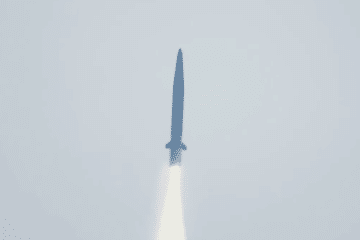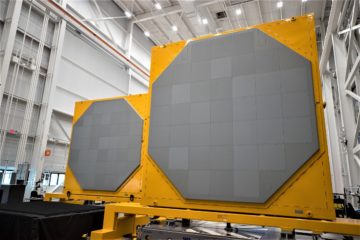The LCF Frigate achieved a first in Europe thanks to its SMART-L MM/N Radar
According to the RNLN, the new SMART-L Multi Mission/Naval radar can detects ballistic missiles up to 2,000 kilometers away. The ship can then can pass on the tracking and detection data to other sea-based or land-defense BMD assets, including U.S. Navy’s warships, that can deal with a ballistic missile threat.
In addition to remote detection, the new SMART-L simultaneously ‘sees’ threats in the airspace. The Zeven Provinciën is able to protect a maritime squadron against anti-ship missiles fired from a distance. For defense against projectiles outside the atmosphere, the Navy needs the Americans. They successfully destroyed a ballistic missile flying 14,000 kilometers per hour through space. This was done with an interceptor missile, fired from the USS Paul Ignatius, but based on the information provided by the SMART-L. The Netherlands itself has no such missiles, which is why a partner took out the ‘enemy’ projectile.
RNLN statement
The Netherlands has been a leader in the field of radar for years. In 2006, the trajectory of a threatening projectile in space was calculated for the first time. At the time, this was done by Holland Signaal, currently Thales. Then, too, there was collaboration with the Americans to destroy the missile. The tests were near Hawaii.
About De Zeven Provinciën-class / LCF Frigates

The Royal Netherlands Navy has 4 air defense and command frigates (LCF) of the De Zeven Provinciën-class. The ships can protect a complete fleet from enemy threats from the sea and from the air (aircraft and missiles). Specialized in anti-aircraft warfare (AAW) vessel, LCF vessels are fitted with 40x Mk41 Vertical Launch Systems which are used to house and launch Evolved Sea Sparrow (ESSM) and SM-2 Block IIIA missiles.
In addition, the ships are equipped to allow the deployable and operational command staff of the Royal Netherlands Navy, the Netherlands Maritime Force (NLMARFOR), to control large-scale (maritime) operations.
The first-in-class ship received her SMART-L Multi Mission radar upgrade from Thales in March 2019. All four ships of the class will be upgraded with the new radar (and other systems) as part of a modernization programme. This new radar is capable of BMD mission (surveillance and tracking of ballistic missiles) up to 2000 km while simultaneous maintaining the air defence capability. The Dutch Defence Material Organisation (DMO) announced in April 2020 that it has selected Italian company Leonardo to supply new 127mm naval gun systems.
LCF Specifications
displacement: 6,050 tons
length: 144 meters
width: 17 meters
draft: 7 meters
speed: 30 knots
About SMART-L MM

According to Thales, the SMART-L MM is a next generation Long Range Multi Mission Radar for Air and Space Surveillance and Ballistic Missile Detection. The fully digitally controlled Active Electronically Scanned Array (AESA) type of radar, applying GaN transmitter and Dual Axis Multibeam receiver technology, is capable of detecting a very wide variety of air and space objects including stealth, short up to long range ballistic missiles and space objects. The SMART-L MM is capable of surveillance and tracking of Ballistic Missiles up to 2000 km while simultaneous maintaining the Air Defence capability. Aboard the LCF vessels, the MM variant replaces the existing SMART-L radars.






